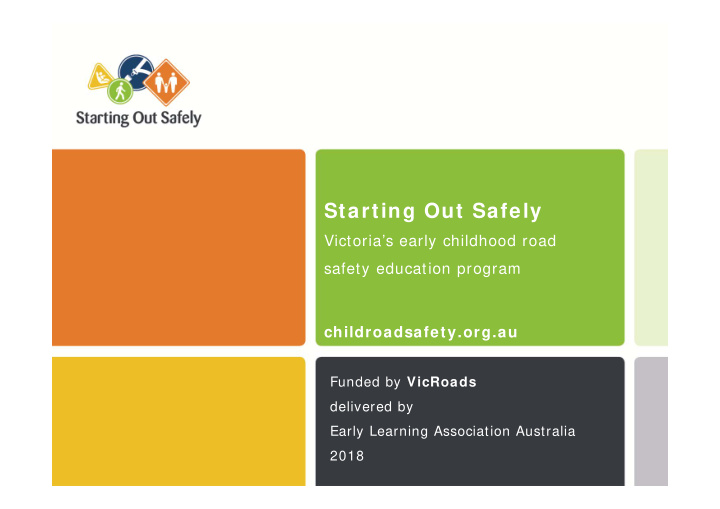



Starting Out Safely Victoria’s early childhood road safety education program childroadsafety.org.au Funded by VicRoads delivered by Early Learning Association Australia 2018
0 -1 2 year olds killed or seriously injured 2 0 1 6 Cyclists 4 Pedestrians 2 4 Passengers 7 2 Total 108* (VicRoads Road Crash Information System as at 1 January 2017) * Includes 1 unknown
All claim s involving hospitalisation for 0 -1 7 year olds 2 0 1 6 Source TAC
W hy children are at risk? Research suggests that road related incidents involving children often occur because children are still developing the skills needed for safe road use, for example, visual timing judgements.
Children as road users Children as Children as Children as Pedestrians Passengers Cyclists
Children as pedestrians
Starting Out Safely Subheading • Bullet point text. • Bullet point text. Subheading Running text/ paragraph. Title of Presentation Page #
Children as pedestrians in early childhood education and care
Children as pedestrians Is there a safe place for families to walk into the service? Are children and families actively encouraged to hold hands when walking near roads and driveways?
Children as passengers
carseatssavelives.com.au
Child restraint best practice
W hen is a child ready for an adult seatbelt? Research recommends that children travel in a booster seat until they can achieve good seatbelt fit (approx. 145 cm tall 1 ) 1. References: (Bilston and Sagar, 2007; Brown and Bilston, 2009)
W hen is a child ready for an adult seatbelt? The 5 step test
Do not leave children in cars In Victoria, it is illegal to leave a child unattended in a vehicle. The fine is $3,690 or a maximum of 6 months jail. Children, Youth and Families Act (2005) Section 494 Page 386
education.vic.gov.au/looklock
Children as cyclists Wearing a helmet reduces the risk of head injury by 60-90% 1 1. Hazard 65, Autumn 2007. Victorian Injury Surveillance and Applied Research System. MUARC
W hat is road safety education? Developing children’s knowledge, attitude and behaviours for safe road use To be effective, road safety education must match the child or young person’s stage of development and level of independence as a road user.
Responding to road safety in early childhood education and care Practices Structures That support That support road safety road safety education. education. Pedagogical Policies and practices that procedures that support children support to be safe road compliance and users. keep children safe.
Structures for road safety Regulations, Law , NQS, QI P and approved fram ew orks
Structures for road safety Road safety and safe transport policy Road safety and safe transport policies provide evidence based guidelines and procedures to ensure that all children attending a service are • adequately supervised at all times including on excursions and regular outings • kept safe as pedestrians, cyclists and/ or passengers when arriving at or leaving the service • able to participate in road safety education to assist them in being and becoming safe and responsible road users. They provide the platform for innovative practice.
Towards Zero 2016//2020 Victoria’s Road Safety Strategy Action Plan “(The Government) will make sure children and families are aware of the importance of using child safety restraints and that services have safe transport policies.” Pg 22 Expect scrutiny in the future regarding your safe transport policy.
Responding to road safety in early childhood education and care Practices Structures That support That support road safety road safety education. education. Pedagogical Policies and practices that procedures that support children support to be safe road compliance and users. keep children safe.
W hat are the key m essages w e are teaching children? ( intentional teaching and instructional support) Stop! Look! Listen! Think! • The safety door • Child car seats
Effective practices for road safety education - Curriculum decisions that prom ote road safety education New picture to follow
Effective practices for road safety education - Getting ‘Out and About’ Road safety education enables children to learn safe ways of being in and contributing to their community. “Children bring family and community ways of being, belonging and becoming into their early childhood settings”. EYLF 2009
How are you getting ‘Out and About’ in your local com m unity?
Effective practices for road safety education - Getting ‘Out and About’ If the service has not previously undertaken excursions include this strategy in the QI P . Suggestions might include developing excursion policies or, if appropriate, increasing the number of excursions and expanding the destinations. Develop a com prehensive road safety, transport and excursion policy that includes specific road safety strategies including routine outings (regular) where documentation only needs to be filled out once if the destination, children, route and risks are the same. Complete a risk assessm ent and excursion perm ission form that include specific strategies for road safety. Com m unicate w ith fam ilies , in advance, preferably in the family handbook or on a service website. For example, inform the family that you plan to regularly take children out into the community to visit places of interest. Highlight the learning outcomes that you hope to achieve. Plan excursions to ensure that educators maximise learning opportunities.
Practice reflection Use the road safety education curriculum tool to consider opportunities to embed road safety education into early childhood programs. http://childroadsafety.org.au/wp ‐ content/uploads/2016/12/Curriculum ‐ tool.pdf
Educator resources Available at w w w .childroadsafety.org.au
Insert website link and picture ELAA contact details
2 0 1 8 Starting Out Safely Road safety education aw ard This award recognises and celebrates the achievements of early childhood in providing road safety education. This award is open to all Victorian early childhood services and educators. The winner will receive $500 for their nominated service.
This presentation can be dow nloaded from the follow ing site childroadsafety.org.au/professional ‐ development
Contact ELAA rse@elaa.org.au Phone 9489 3500
Recommend
More recommend